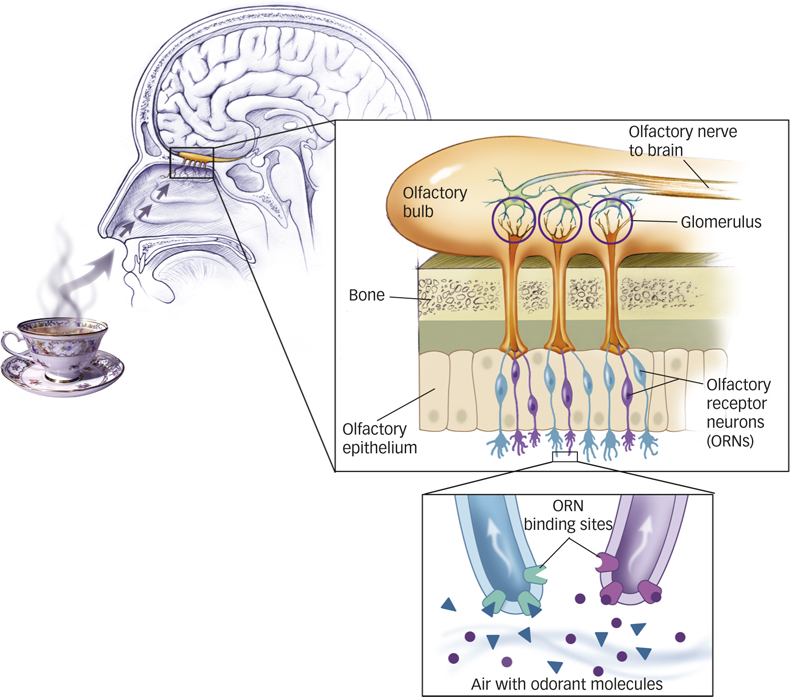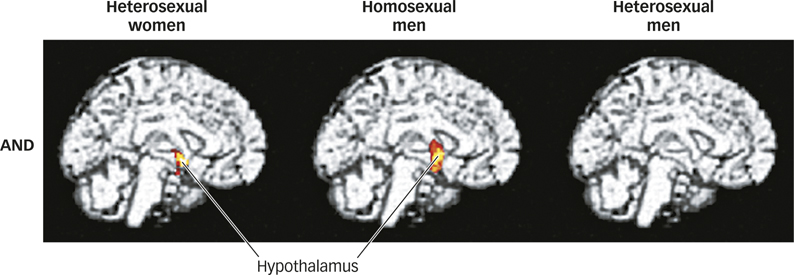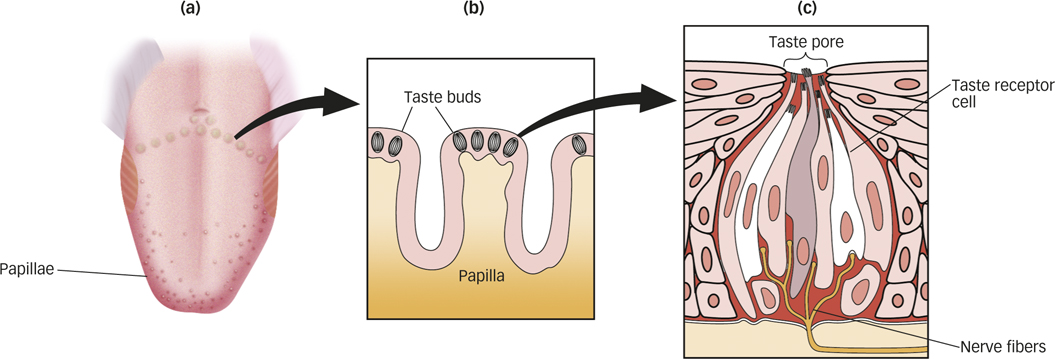4.6 The Chemical Senses: Adding Flavor
Somatosensation is all about physical changes in or on the body: Vision and audition sense energetic states of the world—
Smell
Olfaction is the least understood sense and the only one directly connected to the forebrain, with pathways into the frontal lobe, amygdala, and other forebrain structures (recall from the Neuroscience and Behavior chapter that the other senses connect first to the thalamus). This mapping indicates that smell has a close relationship with areas involved in emotional and social behavior. Smell seems to have evolved in animals as a signaling sense for the familiar: a friendly creature, an edible food, or a sexually receptive mate.
Countless substances release odors into the air, and some of their odorant molecules make their way into our noses, drifting in on the air we breathe. Situated along the top of the nasal cavity shown in FIGURE 4.25 is a mucous membrane called the olfactory epithelium, which contains about 10 million olfactory receptor neurons (ORNs), receptor cells that initiate the sense of smell. Odorant molecules bind to sites on these specialized receptors, and if enough bindings occur, the ORNs send action potentials into the olfactory nerve (Dalton, 2003).

olfactory receptor neurons (ORNs)
Receptor cells that initiate the sense of smell.
128
Each olfactory neuron has receptors that bind to some odorants but not to others, as if the receptor is a lock and the odorant is the key (see FIGURE 4.25). Humans possess about 350 different ORN types that permit us to discriminate among some 10,000 different odorants through the unique patterns of neural activity each odorant evokes. This setup is similar to our ability to see a vast range of colors based on only a small number of retinal receptor cell types or to feel a range of skin sensations based on only a handful of touch receptor cell types.
How many scents can humans smell?
Groups of ORNs send their axons from the olfactory epithelium into the olfactory bulb, a brain structure located above the nasal cavity beneath the frontal lobes. The olfactory bulb sends outputs to various centers in the brain, including the parts that are responsible for controlling basic drives, emotions, and memories. Odor perception includes both information about the identity of an odor, which involves relating olfactory inputs to information stored in memory (Stevenson & Boakes, 2003), as well as our emotional response to whether it is pleasant or unpleasant (Khan et al., 2007). The relationship between smell and emotion explains why smells can have immediate, strongly positive or negative effects on us. If the slightest whiff of an apple pie baking brings back fond memories of childhood, you’ve got the idea.
Our experience of smell is determined not only by bottom-
olfactory bulb
A brain structure located above the nasal cavity beneath the frontal lobes.

Smell may also play a role in social behavior. Humans and other animals can detect odors from pheromones, biochemical odorants emitted by other members of a species that can affect an animal’s behavior or physiology. Parents can distinguish the smell of their own children from other people’s children. An infant can identify the smell of his or her mother’s breast from the smell of other mothers. Pheromones play a role in reproductive behavior in insects and in several mammalian species, including mice, dogs, and primates (Brennan & Zufall, 2006). Research in humans has demonstrated no consistent tendency for people to prefer the odors of people of the opposite sex over other pleasant odors. Recent research, however, has provided a link between sexual orientation and responses to odors. Researchers used positron emission tomography (PET) scans to study the brain’s response to two odors, one related to testosterone, which is produced in men’s sweat, and the other related to estrogen, which is found in women’s urine. The testosterone-

pheromones
Biochemical odorants emitted by other members of its species that can affect an animal’s behavior or physiology.
129
Taste
One of the primary responsibilities of the chemical sense of taste is identifying things that are bad for you—
Why is the sense of taste potentially lifesaving?
The tongue is covered with thousands of small bumps, called papillae, which are easily visible to the naked eye. Within each papilla are hundreds of taste buds, the organ of taste transduction (see FIGURE 4.27). The mouth contains 5,000 to 10,000 taste buds fairly evenly distributed over the tongue, roof of the mouth, and upper throat (Bartoshuk & Beauchamp, 1994; Halpern, 2002). Each taste bud contains 50 to 100 taste receptor cells. Taste perception fades with age (Methven et al., 2012): On average, people lose half their taste receptors by the time they turn 20. This may help to explain why young children seem to be “fussy eaters,” since their greater number of taste buds brings with it a greater range of taste sensations.

taste buds
The organ of taste transduction.
130

The taste system contains just five main types of taste receptors, corresponding to five primary taste sensations: salty, sour, bitter, sweet, and umami (savory). The first four are quite familiar, but umami may not be. In fact, perception researchers are still debating its existence. The umami receptor was discovered by Japanese scientists who attributed it to the tastes evoked by foods containing a high concentration of protein, such as meats and cheeses (Yamaguchi, 1998). If you’re a meat eater and you savor the feel of a steak topped with butter or a cheeseburger as it sits in your mouth, you’ve got an idea of the umami sensation. The food additive monosodium glutamate (MSG), which is often used to flavor Asian foods, particularly activates umami receptors. Some people develop headaches or allergic reactions after eating MSG.
DATA VISUALIZATION
Finding Best Fits/Models for Data Sets (Sensation and Perception Themed) www.macmillanhighered.com/
Of course, the variety of taste experiences greatly exceeds the five basic receptors discussed here. Any food molecules dissolved in saliva evoke specific, combined patterns of activity in the five taste receptor types. Although we often think of taste as the primary source for flavor, in fact, taste and smell collaborate to produce this complex perception. As any wine connoisseur will attest, the full experience of a wine’s flavor cannot be appreciated without a finely trained sense of smell. Odorants from substances outside your mouth enter the nasal cavity via the nostrils, and odorants in the mouth enter through the back of the throat. This is why wine aficionados are taught to pull air in over wine held in the mouth: It allows the wine’s odorant molecules to enter the nasal cavity through this “back door.”
You can easily demonstrate the contribution of smell to flavor by tasting a few different foods while holding your nose, preventing the olfactory system from detecting their odors. If you have a head cold, you probably already know how this turns out. Your favorite spicy burrito or zesty pasta probably tastes as bland as can be.

Taste experiences also vary widely across individuals. About 50% of people report a mildly bitter taste in caffeine, saccharine, certain green vegetables, and other substances, whereas roughly 25% report no bitter taste. Members of the first group are called tasters, and members of the second group are called nontasters. The remaining 25% of people are supertasters, who report that such substances, especially dark green vegetables, are extremely bitter, to the point of being inedible (Bartoshuk, 2000). Children start out as tasters or supertasters, which could help explain their early tendency toward fussiness in food preference. There is evidence that genetic factors contribute to individual differences in taste perception (Kim et al., 2003), but much remains to be learned about the specific genes that are involved (Hayes et al., 2008; Reed, 2008).
131
SUMMARY QUIZ [4.6]
Question 4.15
| 1. | What best explains why smells can have immediate and powerful effects? |
- the involvement in smell of brain centers for emotions and memories
- the vast number of olfactory receptor neurons we have
- our ability to detect odors from pheromones
- the fact that different odorant molecules produce varied patterns of activity
a.
Question 4.16
| 2. | People lose about half their taste buds by the time they are |
- 20
- 40
- 60
- 80
a.